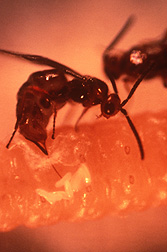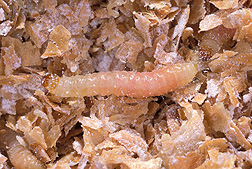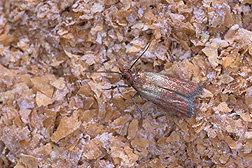Parasitic Wasps: Serve Chilled
Small parasitoid wasps could become important allies in the fight to reduce multi-billion-dollar losses caused by stored-product pests, offering warehouse and retail managers a biological alternative to chemical controls, which can be costly and environmentally worrisome to use.
The top recruit is Habrobracon hebetor, a 2- to 3-millimeter-long, reddish-brown wasp that seeks out the caterpillar offspring of hosts like the Indianmeal moth and immobilizes them with a paralyzing sting. The wasp then deposits several eggs on her quarry. Within a few days, her maggotlike brood emerge to suck out their host’s juices. Afterwards, they spin a cocoon and pupate before emerging as adult wasps, ready to start the cycle over.
Studies with packaged commodities, conducted by Agricultural Research Service scientists in the Stored Product Insect Research Unit (SPIRU) in Manhattan, Kansas, indicate that releasing H. hebetor wasps can reduce Indianmeal moth populations by 71 percent—and 97 percent if combined with the egg parasitoid Trichogramma deion. Sanitation and fumigation are among methods now used to control the pest, which causes harm directly, by feeding on grains and other edible stored goods, and indirectly, by leaving behind bits of cocoon, frass, and other debris.
“Indianmeal moths are very difficult to control because they feed on almost any food material, but the parasitoids search them out very well,” says SPIRU research leader James Throne. Their parasitism also cuts down on contaminants the pest leaves behind. And “once parasitoids get established, they provide a continual control program of their own doing,” he adds.
|
|
For all its biocontrol promise, though, H. hebetor has yet to be used (in the United States, at least) as a frontline defense by warehouse or retail managers. In part, this is due to the difficulty commercial insectaries have had in mass-producing sufficient numbers of the wasp, whose eggs must be hatched and reared on living, captive hosts.
“There’s interest by industry,” Throne says, but no one company has taken the lead in commercializing the parasitoids.
Science, however, has pushed on.
Together with colleagues from Kansas State University-Manhattan and Huazhong Agricultural University (HAU) in Wuhan, China, Throne has focused attention on an insect resting state called “reproductive diapause.”
In short, they found that they could artificially induce the diapause state in H. hebetor wasps by “conditioning” them for prolonged refrigerated storage after rearing. In trials, the diapause-induced wasps generally survived cold storage for up to 2 months at 41°F. But this depended on the set of conditioning temperatures and light-exposure periods used.
|
|
Throughout the experiments, the researchers compared the health, longevity, egg production, and other attributes of the diapause-induced wasps to a control group, which had not been conditioned. They found little significant difference between the two groups, aside from a lower percentage of female offspring from diapaused wasps than from nondiapaused ones (36 versus 52 percent).
Of the range of wasp-conditioning protocols the researchers evaluated, the optimal combination was 68 °F and a photoperiod exposure of 10 hours. “Cold storage provides flexibility and efficiency in mass production and minimizes the costs of maintaining a colony during periods when releases are not required,” reports the team, led by HAU graduate student Haoliang Chen, in a paper published in Environmental Entomology.
Small-scale tests in sheds simulating warehouse conditions are planned to evaluate the wasp’s parasitism rates following release from cold storage.—By Jan Suszkiw, Agricultural Research Service Information Staff.
This research is part of Crop Protection and Quarantine, an ARS national program (#304) described at www.nps.ars.usda.gov.
James Throne is in the USDA-ARS Stored Product Insect Research Unit, 1515 College Ave., Manhattan, KS 66502; (785) 776-2796.
"Parasitic Wasps: Serve Chilled" was published in the October 2012 issue of Agricultural Research magazine.









